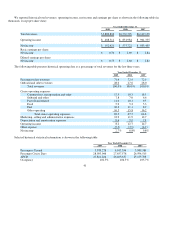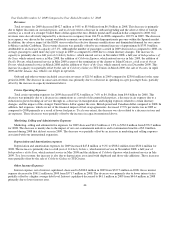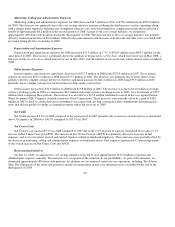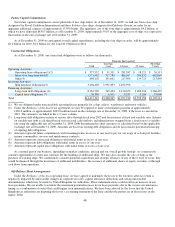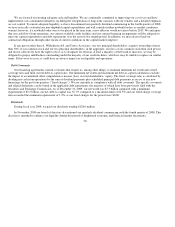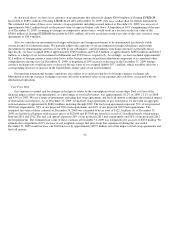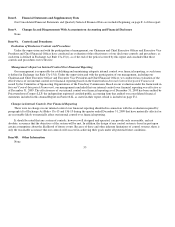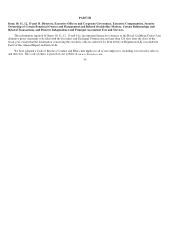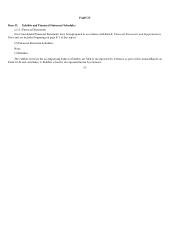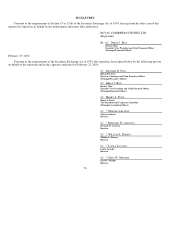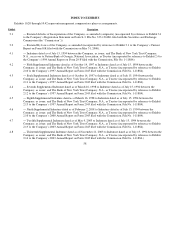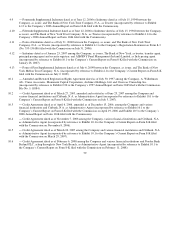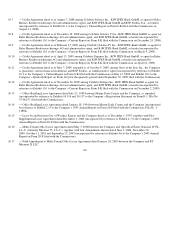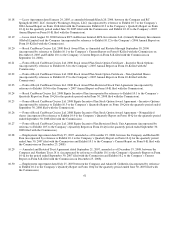Royal Caribbean Cruise Lines 2009 Annual Report Download - page 61
Download and view the complete annual report
Please find page 61 of the 2009 Royal Caribbean Cruise Lines annual report below. You can navigate through the pages in the report by either clicking on the pages listed below, or by using the keyword search tool below to find specific information within the annual report.
Financial Instruments and Other
General
We are exposed to market risk attributable to changes in interest rates, foreign currency exchange rates and fuel prices. We
manage these risks through a combination of our normal operating and financing activities and through the use of derivative financial
instruments pursuant to our hedging practices and policies. The financial impacts of these hedging instruments are primarily offset by
corresponding changes in the underlying exposures being hedged. We achieve this by closely matching the amount, term and
conditions of the derivative instrument with the underlying risk being hedged. We do not hold or issue derivative financial
instruments for trading or other speculative purposes. We monitor our derivative positions using techniques including market
valuations and sensitivity analyses. (See Note 13. Fair Value Measurements and Derivative Instruments to our consolidated financial
statements under Item 8. Financial Statements and Supplementary Data.)
The turmoil in the credit and capital markets over the past couple of years has increased the volatility associated with interest
rates, foreign currency exchange rates and fuel prices. However, we are taking steps to mitigate these risks.
Interest Rate Risk
Our exposure to market risk for changes in interest rates relates to our long-term debt obligations and our operating lease for
B
rilliance of the Seas. At December 31, 2009, approximately 43% of our long-term debt was effectively fixed and approximately
57% was floating. We enter into interest rate swap agreements to modify our exposure to interest rate movements and to manage our
interest expense and rent expense.
Market risk associated with our long-term fixed rate debt is the potential increase in fair value resulting from a decrease in
interest rates. At December 31, 2009, our interest rate swap agreements effectively changed $350.0 million of fixed rate debt with a
fixed rate of 7.25% to LIBOR-based floating rate debt, and €€1.0 billion of fixed rate debt with a fixed rate of 5.625% to EURIBOR-
based floating rate debt. We have cross currency swap agreements that effectively change €€300.0 million of the €€1.0 billion floating
EURIBOR-based debt to floating LIBOR-based debt. (See Foreign Currency Exchange Rate Risk for further information). The
estimated fair value of our long-term fixed rate debt at December 31, 2009, was $5.1 billion using quoted market prices, where
available, or using the present value of expected future cash flows which incorporates risk profile. The fair value of our associated
interest rate swap and cross currency swap agreements including accrued interest was estimated to be an asset of $229.1 million as of
December 31, 2009 based on the present value of expected future cash flows. A hypothetical one percentage point decrease in interest
rates at December 31, 2009 would increase the fair value of our long-term fixed rate debt by approximately $95.4 million, net of an
increase in the fair value of the associated interest rate swap agreements.
Market risk associated with our long-term floating rate debt is the potential increase in interest expense from an increase in
interest rates. A hypothetical one percentage point increase in interest rates would increase our 2010 interest expense by
approximately $41.2 million, assuming no change in exchange rates.
Market risk associated with our operating lease for Brilliance of the Seas is the potential increase in rent expense from an
increase in sterling LIBOR rates. As of January 2009, we have effectively changed 49% of the operating lease obligation from a
floating rate to a fixed rate obligation with a weighted-average rate of 4.76% through rate fixings with the lessor. A hypothetical one
percentage point increase in sterling LIBOR rates would increase our 2010 rent expense by approximately $1.5 million, based on the
exchange rate at December 31, 2009.
Foreign Currency Exchange Rate Risk
Our primary exposure to foreign currency exchange rate risk relates to our ship construction firm commitments denominated in
euros. We enter into euro-denominated forward contracts to manage this risk. The estimated fair value of such euro-denominated
forward contracts at December 31, 2009, was estimated to be a liability of $3.3 million, based on the present value of expected future
cash flows. At December 31, 2009, approximately 9.0% of the aggregate cost of the ships was exposed to fluctuations in the euro
exchange rate. A hypothetical 10% strengthening of the euro as of December 31, 2009, assuming no changes in comparative interest
rates, would result in a $38.1 million increase in the United States dollar cost of the foreign currency denominated ship construction
contracts exposed to fluctuations in the euro exchange rate.
51
Item 7A. Quantitative and Qualitative Disclosures About Market Risk


